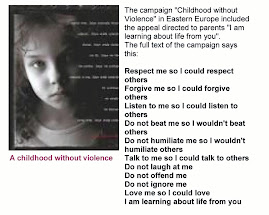

Monday, 30 July 2007
2007 07: Cop: Children under pressure to run away
The Star Online. News. Nation. Wednesday July 25, 2007
KUALA LUMPUR: About a quarter of all children who left home did so due to peer pressure.
Criminal Investigation Department Deputy Director II Deputy Comm Datuk Acryl Sani Abdullah Sani said that between January 2004 and May 2007, 6,270 children, below 18 years of age, were reported missing.
The police have reunited 4,237 of them with their respective families but 2,033 other children remain missing nationwide.
DCP Acryl Sani cited several reasons for the children running away from home. They are:
PEER pressure;
YEARNING for freedom;
ELOPING with their boyfriend/girlfriend; and,
LOOKING for job opportunities in urban areas.
He suggested that parents communicate with their children always to overcome any misunderstanding.
“In my personal opinion, between eight and 10 cases of missing children are linked to peer pressure.
“So parents, please talk to your children and understand them,” DCP Acryl Sani told reporters yesterday after launching the RHB Missing Children – Reuniting Families campaign at a hotel here.
He said that Kedah, Johor and Selangor recorded the highest number of cases.
He added that the 578 reported cases of missing children between January and May this year marked a drop from 762 in the corresponding period last year.
Meanwhile, a teenage girl who was last seen taking a taxi in front of her school in Sri Petaling on June 11 has been reported missing.
Tien Yee Wah, 16, was spotted boarding the taxi at about 7am by her schoolmate.
The missing girl’s father, mechanic Tien Yem Ngok, 55, said that he had last spoken to his daughter on July 12 when she called the schoolmate outside the school. – Bernama
............................................................
Last resort
The Star Online. Youth2. Wednesday August 22, 2007
Breakdown in family relations is one of the main reasons teenagers escape from home
CLARA’S decision to leave home was sudden, but it had been coming for a long time. The beating she received from her stepmother the night before she ran away was the final straw, but it was the image of her mother standing by and watch ing silently that steeled her resolve.
Her mother and stepmother are siblings married to Clara’s alcoholic father. The 17- year-old girl had endured physical and men tal torture for as long as she remembered.
My stepmother often accuses me of being immoral and my mother usually takes her side. My mother would rather listen to her sister than to her own daughters,” says Clara, who once had to strip naked and allow her stepmother to examine her private parts to prove that she had not slept with the boy she was seen talking to.
“I have been enduring the pain for too long. I needed to escape from my abusive sur rounding and that’s why I left,” she explains.
Clara is but one of the 6,270 teenagers reported missing from their homes since 2004 in Malaysia. Last year, 3,246 girls were reported missing.
Most would eventually be found and reunited with their families. Criminal Investigation Department deputy director Deputy Comm Datuk Acryl Sani Abdullah Sani reported that between January 2004 and May this year, 67.5% (4,237) of the missing teenagers were found.
“Teens run away because they can’t get the freedom or the understanding they seek from their family. Running away becomes their solution because they don’t know how to deal with the problems anymore,” says MCA Public Services and Complaints Department head Datuk Michael Chong.
When a parent reports that a child is miss ing, Chong’s department would check with agencies such as the police and the immigra tion department before seeking the public’s help through the media.
Chong says that media attention is always the last resort because it’s a double-edged sword – over 80% of the cases highlighted in the media are successfully solved, but reper cussions such as violation of the family’s rep utation and privacy are also unavoidable.
“There are actually very few cases where runaway or missing teens are cheated by pimps, which were common 15 years ago. Most cases nowadays stem from feuds or misunderstandings between the child and their parents,” adds Chong.
Through an in-house survey, James Nayagam, executive director of Shelter home for children, found that most girls who leave their home have a troubled relationship with their parents, if not boy problems. “It takes a lot for a girl to decide to run,” he says, “and when she does, it’s often because she doesn’t see another way out.”
There are two contributing factors to this problem, he adds – either the girl runs away because of peer influence or she just wants to teach her parents a lesson.
The study also showed that the most vul nerable age group among the runaway teens is from 16 to 18 and most of the kids under this category suffer from a condition Nayagam refers to as ‘attachment disorder’. “This usually happens when the kids find themselves not emotionally attached to any one at home, thus making it easier for them to just leave everything behind.”
According to Nayagam, children who are attached to their parents rarely make the decision to run away from home because they feel everything that children are sup posed to feel – happy and belonged.
“When I spoke to the girls who came for help, I realised that most of them wouldn’t have run away if only they had someone to talk them out of it,” says Nayagam. But when they do come to him, Nayagam ensures that they get all the help that they need. No prodding questions are asked when a girl steps into the Shelter vicinity. ”If a troubled girl wants help and shelter, then that’s what she gets from us,” says James.
Runaway Clara turned to her best friend’s family for help when she left home, and it was her friend’s mother who took her to Nayagam’s Shelter.
She had since settled in at the Shelter, and has no intentions of returning to her family. “I am happy here and am looking forward to go to a new school. If that’s impossible, I’ll just study at this shelter and sit for the SPM examination later this year,” says Clara, a bright student who has even represented her previous school for marathons in district levels.
The girls are allowed to stay at the Shelter until they turn 18, but there are also some who attempt to reunite with their families. “Most cases are resolved when the teen returns to his/her family and discuss their problems openly with each other. But we’ve also encountered some situations where the runaways would come to us and tell us their intention to leave their homes and request us not to expose the matter to the media if their families seek our help,” says Chong. James spoke of a case in which he brought a girl back home to her worried parents. “The first thing that the father asked the girl was ‘Why?’ a question which I think builds up a wall around a person faster than any other question could,” says James. The girl then replied that although she had everything in the big, beautiful house ... it was missing love.
That, James says, is what every girl wants from her home. Chong agrees. “Parents need to spend more quality time with their children and really listen to their needs. They must also set good examples of themselves – you can’t expect a child to respect or be obedient when the parents are full of vices,” says Chong.
KUALA LUMPUR: About a quarter of all children who left home did so due to peer pressure.
Criminal Investigation Department Deputy Director II Deputy Comm Datuk Acryl Sani Abdullah Sani said that between January 2004 and May 2007, 6,270 children, below 18 years of age, were reported missing.
The police have reunited 4,237 of them with their respective families but 2,033 other children remain missing nationwide.
DCP Acryl Sani cited several reasons for the children running away from home. They are:
PEER pressure;
YEARNING for freedom;
ELOPING with their boyfriend/girlfriend; and,
LOOKING for job opportunities in urban areas.
He suggested that parents communicate with their children always to overcome any misunderstanding.
“In my personal opinion, between eight and 10 cases of missing children are linked to peer pressure.
“So parents, please talk to your children and understand them,” DCP Acryl Sani told reporters yesterday after launching the RHB Missing Children – Reuniting Families campaign at a hotel here.
He said that Kedah, Johor and Selangor recorded the highest number of cases.
He added that the 578 reported cases of missing children between January and May this year marked a drop from 762 in the corresponding period last year.
Meanwhile, a teenage girl who was last seen taking a taxi in front of her school in Sri Petaling on June 11 has been reported missing.
Tien Yee Wah, 16, was spotted boarding the taxi at about 7am by her schoolmate.
The missing girl’s father, mechanic Tien Yem Ngok, 55, said that he had last spoken to his daughter on July 12 when she called the schoolmate outside the school. – Bernama
............................................................
Last resort
The Star Online. Youth2. Wednesday August 22, 2007
Breakdown in family relations is one of the main reasons teenagers escape from home
CLARA’S decision to leave home was sudden, but it had been coming for a long time. The beating she received from her stepmother the night before she ran away was the final straw, but it was the image of her mother standing by and watch ing silently that steeled her resolve.
Her mother and stepmother are siblings married to Clara’s alcoholic father. The 17- year-old girl had endured physical and men tal torture for as long as she remembered.
My stepmother often accuses me of being immoral and my mother usually takes her side. My mother would rather listen to her sister than to her own daughters,” says Clara, who once had to strip naked and allow her stepmother to examine her private parts to prove that she had not slept with the boy she was seen talking to.
“I have been enduring the pain for too long. I needed to escape from my abusive sur rounding and that’s why I left,” she explains.
Clara is but one of the 6,270 teenagers reported missing from their homes since 2004 in Malaysia. Last year, 3,246 girls were reported missing.
Most would eventually be found and reunited with their families. Criminal Investigation Department deputy director Deputy Comm Datuk Acryl Sani Abdullah Sani reported that between January 2004 and May this year, 67.5% (4,237) of the missing teenagers were found.
“Teens run away because they can’t get the freedom or the understanding they seek from their family. Running away becomes their solution because they don’t know how to deal with the problems anymore,” says MCA Public Services and Complaints Department head Datuk Michael Chong.
When a parent reports that a child is miss ing, Chong’s department would check with agencies such as the police and the immigra tion department before seeking the public’s help through the media.
Chong says that media attention is always the last resort because it’s a double-edged sword – over 80% of the cases highlighted in the media are successfully solved, but reper cussions such as violation of the family’s rep utation and privacy are also unavoidable.
“There are actually very few cases where runaway or missing teens are cheated by pimps, which were common 15 years ago. Most cases nowadays stem from feuds or misunderstandings between the child and their parents,” adds Chong.
Through an in-house survey, James Nayagam, executive director of Shelter home for children, found that most girls who leave their home have a troubled relationship with their parents, if not boy problems. “It takes a lot for a girl to decide to run,” he says, “and when she does, it’s often because she doesn’t see another way out.”
There are two contributing factors to this problem, he adds – either the girl runs away because of peer influence or she just wants to teach her parents a lesson.
The study also showed that the most vul nerable age group among the runaway teens is from 16 to 18 and most of the kids under this category suffer from a condition Nayagam refers to as ‘attachment disorder’. “This usually happens when the kids find themselves not emotionally attached to any one at home, thus making it easier for them to just leave everything behind.”
According to Nayagam, children who are attached to their parents rarely make the decision to run away from home because they feel everything that children are sup posed to feel – happy and belonged.
“When I spoke to the girls who came for help, I realised that most of them wouldn’t have run away if only they had someone to talk them out of it,” says Nayagam. But when they do come to him, Nayagam ensures that they get all the help that they need. No prodding questions are asked when a girl steps into the Shelter vicinity. ”If a troubled girl wants help and shelter, then that’s what she gets from us,” says James.
Runaway Clara turned to her best friend’s family for help when she left home, and it was her friend’s mother who took her to Nayagam’s Shelter.
She had since settled in at the Shelter, and has no intentions of returning to her family. “I am happy here and am looking forward to go to a new school. If that’s impossible, I’ll just study at this shelter and sit for the SPM examination later this year,” says Clara, a bright student who has even represented her previous school for marathons in district levels.
The girls are allowed to stay at the Shelter until they turn 18, but there are also some who attempt to reunite with their families. “Most cases are resolved when the teen returns to his/her family and discuss their problems openly with each other. But we’ve also encountered some situations where the runaways would come to us and tell us their intention to leave their homes and request us not to expose the matter to the media if their families seek our help,” says Chong. James spoke of a case in which he brought a girl back home to her worried parents. “The first thing that the father asked the girl was ‘Why?’ a question which I think builds up a wall around a person faster than any other question could,” says James. The girl then replied that although she had everything in the big, beautiful house ... it was missing love.
That, James says, is what every girl wants from her home. Chong agrees. “Parents need to spend more quality time with their children and really listen to their needs. They must also set good examples of themselves – you can’t expect a child to respect or be obedient when the parents are full of vices,” says Chong.
Subscribe to:
Post Comments (Atom)



No comments:
Post a Comment